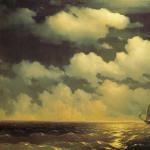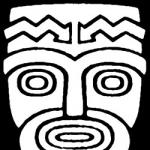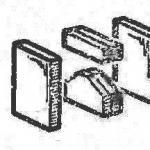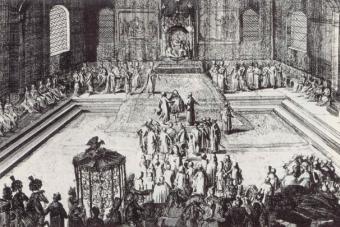Optical illusion is an unreliable visual perception of any picture: an incorrect assessment of the length of the segments, the color of the visible object, the magnitude of the angles, etc.
The reasons for such errors lie in the peculiarities of the physiology of our vision, as well as in the psychology of perception. Sometimes illusions can lead to absolutely incorrect quantitative estimates of specific geometric quantities.

Even carefully looking at the "optical illusion" picture, in 25 percent or more of cases you can make a mistake if you do not check the eye estimates with a ruler.

Illusion pictures: size
For example, consider the following figure.

Optical Illusion Pictures: Circle Size
Which of the circles located in the middle is larger?

Correct Answer: The circles are the same.
Illusion Pictures: Proportions
Which of the two people is taller: the dwarf in the foreground or the person walking behind everyone? 
Correct Answer: They are the same height.
Illusion pictures: length
The figure shows two segments. Which one is longer?

Correct Answer: They are the same.
Illusion Pictures: Pareidolia
One type of visual illusion is pareidolia. Pareidolia is an illusory perception of a particular object.
Unlike illusions of length perception, depth perception, dual images, pictures with images that are specifically designed to provoke the appearance of illusions, pareidolia can occur on their own when viewing the most ordinary objects. So, for example, sometimes when looking at a pattern on a wallpaper or a carpet, clouds, spots and cracks on the ceiling, one can see fantastic changing landscapes, unusual animals, people's faces, etc.
The basis of various illusory images can be the details of a real-life drawing. The first to describe this phenomenon were Jaspers and Kalbaumi (Jaspers K., 1913, Kahlbaum K., 1866;). Many pareidolic illusions can arise from the perception of well-known images. In this case, such illusions can take place simultaneously in several people.
So, for example, in the following picture, which shows the building of the World Trade Center on fire. Many people can see the terrible face of the devil on it. 
The image of the devil can be seen in the next picture - the devil in the smoke 
In the following picture, one can easily make out the face on Mars (NASA, 1976). The play of shadow and light has given rise to many theories about ancient Martian civilizations. Interestingly, in the later images of this region of Mars, the face is not detected.

And here you can see the dog.

Illusion Pictures: Color Perception
Looking at the picture, you can observe the illusion of color perception. 
In fact, the circles on different squares are the same shade of gray.
Looking at the following picture, answer the question: are the chess cells on which points A and B are located the same or different colors?

It's hard to believe, but yes! Don't believe? Photoshop will prove it to you.
How many colors do you enter in the following picture?

There are only 3 colors - white, green and pink. You may think that there are 2 shades of pink, but in fact it is not.
What do these waves look like to you?

Are the brown waves-stripes painted? But no! This is just an illusion.
Look at the following picture and say the color of each word.

Why is it so difficult? The fact is that one part of the brain is trying to read the word, while the other perceives the color.
Illusion Pictures: Elusive Objects
Looking at the following image, look at the black dot. After a while, the colored spots should go away. 
Do you see the gray diagonal stripes?

If you look at the center dot for a while, the stripes will disappear.
Illusion Pictures: Changeling
Another type of visual illusion is a shifter. The fact is that the very image of the object depends on the direction of your gaze. So, one of these optical illusions is the “duck hare”. This image can be interpreted both as an image of a hare and as an image of a duck. 
Take a closer look, what do you see in the next picture? 
What do you see in this picture: a musician or a girl's face?

Oddly enough, it's actually a book.
A few more pictures: an optical illusion





If you look at the black color of this lamp for a long time, and then look at the white sheet of paper, then this lamp will be visible there too.

Look at the dot, and then back away a little and get closer to the monitor. The circles will spin in different directions.

That. features of optical perception are complex. Sometimes you can't believe your eyes...
The snakes crawl in different directions.

Aftereffect illusion
After looking at an image continuously for a long period, there will be some effect on vision for a while. For example, prolonged contemplation of a spiral leads to the fact that all objects around will rotate for 5-10 seconds.


shadow shape illusion
This is a common type of erroneous perception, when a person guesses a figure in the shadow with peripheral vision.


Irradiation
This is a visual illusion that leads to a distortion of the size of an object placed on a background with a contrasting color.


Phosphene phenomenon
This is the appearance of unclear dots of different shades in front of closed eyes.


Depth perception
This is an optical illusion, implying two options for perceiving the depth and volume of an object. Looking at the image, a person does not understand a concave object or a convex one.


Optical illusions: video















Guys, we put our soul into the site. Thanks for that
for discovering this beauty. Thanks for the inspiration and goosebumps.
Join us at Facebook and In contact with
Even the most hardened skeptics believe what their senses tell them, but the senses are easily deceived.
An optical illusion is an impression of a visible object or phenomenon that does not correspond to reality, i.e. optical illusion. Translated from Latin, the word "illusion" means "mistake, delusion." This suggests that illusions have long been interpreted as some kind of malfunction in the visual system. Many researchers have studied the causes of their occurrence.
Some visual deceptions have long had a scientific explanation, others still remain a mystery.
website continues to collect the coolest optical illusions. Be careful! Some illusions can cause tearing, headache, and disorientation in space.
Endless Chocolate
If you cut a chocolate bar 5 by 5 and rearrange all the pieces in the order shown, then, out of nowhere, an extra chocolate piece will appear. You can do the same with an ordinary chocolate bar and make sure that this is not computer graphics, but a real-life mystery.
Illusion of bars
Take a look at these bars. Depending on which end you are looking at, the two pieces of wood will either be next to each other, or one of them will lie on top of the other.
Cube and two identical cups
An optical illusion created by Chris Westall. There is a cup on the table, next to which there is a cube with a small cup. However, upon closer inspection, we can see that in fact the cube is drawn, and the cups are exactly the same size. A similar effect is noticed only at a certain angle.
Cafe wall illusion
Take a close look at the image. At first glance, it seems that all the lines are curved, but in fact they are parallel. The illusion was discovered by R. Gregory at the Wall Cafe in Bristol. That's where its name came from.
Illusion of the Leaning Tower of Pisa
Above you see two pictures of the Leaning Tower of Pisa. At first glance it looks like the tower on the right is leaning more than the one on the left, but the two pictures are actually the same. The reason lies in the fact that the visual system considers two images as part of a single scene. Therefore, it seems to us that both photographs are not symmetrical.
Disappearing circles
This illusion is called "Disappearing Circles". It consists of 12 lilac pink spots arranged in a circle with a black cross in the middle. Each spot disappears in a circle for about 0.1 seconds, and if you focus on the central cross, you can get the following effect:
1) at first it will seem that a green spot is running around
2) then the purple spots will start to disappear
Black and white illusion
Stare at the four dots in the center of the picture for thirty seconds, then move your gaze up to the ceiling and blink. What did you see?
fading

Apparently reality depends on how the brain is able to interpret the environment. What if your brain receives false information through the senses if your version of reality is not "real"?
The example images below are trying to trick your brain and show you a false reality. Fun viewing!
In fact, these squares are the same color. Place your finger horizontally on the border between both shapes and see how everything changes.

Photo: unknown
If you stare at this lady's nose for 10 seconds and then blink rapidly at a light surface, her face should appear in full color.

Photo: unknown
These cars look like they're different sizes...

Photo: Neatorama
But in fact they are the same.

These dots seem to change color and rotate around the center. But focus on one point - there is no rotation or color change.

Photo: reddit

Photo: unknown
This park in Paris looks like a giant 3D globe...

But in fact it is completely flat.

Photo: unknown
Which of the orange circles looks bigger?

Surprisingly, they are the same size.

Photo: unknown
Look at the yellow dot, then move closer to the screen - the pink rings will start to rotate.

Photo: unknown
The Pinn-Brelstaff illusion occurs due to a lack of peripheral vision.
Believe it or not, the squares marked "A" and "B" are the same shade of gray.

Photo: DailyMail

Photo: WikiMedia
The brain automatically adjusts color based on surrounding shadows.
Look at this swirling picture for 30 seconds and then move your attention to the photo below.


Photo: unknown
The previous GIF tired your eyes, so the still photo came to life trying to regain balance.
"Ames Room" - the illusion creates confusion in the perception of the depth of the room through a change in the angle of the back wall and ceiling.

Photo: unknown
It looks like the yellow and blue blocks are moving one after the other, right?

Photo: Michaelbach
If you remove the black bars, you can see that the blocks are always parallel, but the black bars distort the perception of movement.
Slowly move your head towards the image - and the light in the middle will become brighter. Move your head back - and the light will become weaker.

Photo: unknown
This is an illusion called "Dynamic Gradient Brightness" by Alan Stubbs of the University of Maine.
Focus on the center of the color version, wait for the black and white one to appear.

Photo credit: imgur
Instead of black and white, your brain fills the picture with the colors it thinks you should see based on orange and blue. Another moment - and you will return to black and white.
All dots in this photo are white, but some appear black.

Photo: unknown
No matter how hard you try, you will never be able to look directly at the black dots that appear in the circles. How this illusion works has not yet been figured out.
By manipulating the human brain and vision, Brusspup is able to create amazing animations with just a black card.

Photo: brusspup
Dinosaur eyes are watching you...

Photo: brusspup
Akioshi Kitaoka uses geometric shapes, colors and brightness to create the illusion of movement. These images are not animated, but the human brain makes them move.

Photo: ritsumel
Using similar techniques, Randolph creates similar, more psychedelic illusions.

Photo: flickr

Photo: Beau Deeley
Photographers can create amazing two-faced portraits by layering multiple images on top of each other.

Photo: Robble Khan
How is this train moving? If you stare long enough, your brain will change direction.

Photo: unknown
Do you think the dancer in the middle is spinning clockwise or counterclockwise? Round trip.

Photo: unknown
The middle dancer changes direction depending on which girl you first look at: the one on the left or the one on the right.
Using ingenious design, artists like Ibride are able to create 3D art that looks incredible.

Photo: brusspup


Keep your eyes on the flashing green dot for a few seconds and see what happens to the yellow dots...

Photo: Michaelbach
Petrova Oksana
Download:
Preview:
To use the preview, create yourself a Google account (account) and log in: https://accounts.google.com
Preview:
To use the preview of presentations, create a Google account (account) and sign in: https://accounts.google.com
Slides captions:
Why are mistakes made in evaluating and comparing the lengths of a segment, the magnitude of the angles, in the perception of the shape of objects, etc.? performed by the observer under certain conditions. Relevance
Explain the visual illusion in terms of geometry and conduct social research. Target
1 Study the theoretical material on the topic. 2 show the application of the use of illusions in art, in mathematics, in real life. 3 Conduct a study showing the limitations of our eyes. Challenges
Illusions Drawings Subject of study Subject of study Hypothesis If our perception is deceptive, then the simplest things, if you look at them, are fraught with the most unexpected discoveries. Visual illusions can be explained using the laws of geometry.
1 Study 3 analysis, generalization Research methods 2 search 4 synthesis, classification
Varieties of illusions
Optical Illusions Optical illusions are, simply put, an optical illusion of our brain. When our eye receives a picture, a huge number of processes in our brain turn on.
optical illusions
Consider a figure made up of rhombuses and triangles. Is it true that the width is smaller than the height? Conclusion: However, they are the same, and if we connect the vertices of sharp corners, we get a square.
The Illusion of Movement The perception of movement is a very complex process, the nature of which has not yet been fully elucidated. If an object is objectively moving in space, then we perceive its movement due to the fact that it leaves the area of best vision and thereby forces us to move our eyes or head in order to fix our gaze on it again.
illusions of movement on which the principle of cinematography is based. Look at the center of the picture (on the right). Violet and blue rings will flicker. Some also notice a circular rotation. And in the picture on the left, look closely at the ball in the center. It seems that the pattern on it is moving from side to side. Without taking your eyes off the center of the circle, move your head. There was an illusion that the pattern around the ball is shifting.
Vertical-horizontal illusion. The vertical line is perceived as longer. If you look at the drawing with one eye, then the effect is somewhat reduced. The feeling of vertical and horizontal directions depends not only on visual impressions, legs and stereotypes formed in the human brain
Vertical-horizontal illusion. The students were asked to determine "by eye" which of the lines is longer: vertical or horizontal. Vertical length Equal in length I know this effect Total 18 (75%) 4 (18%) 2 (7%) 24 (100%)
Illusion by Franz Müller-Lyer. The arrows at the ends of the segments create the illusion of length distortion, so the same segments are perceived as unequal. But in fact the segments are equal.
Children (20) Adults (10) Total (30) Line segments equal 4 (20%) 4 (40%) 8 (27%) Blue line greater than 16 (80%) 6 (60%) 22 (73%) Muller Illusion- Layer Verno was correctly identified by 20% of children and 40% of adults.
Poggendorff illusion. An amazing impression is made by a picture with two parallel intersecting oblique lines. If the right line is continued, then it will intersect the left one at its upper end. The apparent intersection point is somewhat to the right.
Continuation of line A Continuation of line B Between lines A and B Total 3 (17%) 4 (23%) 10 (60%) 17(100%) Poggendorff illusion The students were asked the question: "Which line is continued by line C?"
Illusion of parallelograms. A striking illusion is created by angles - obtuse and sharp; the diagonals AB and AC of the two parallelograms are equal, although the diagonal AC seems to be much shorter.
Illusion of parallelograms
Impossible Tiles. How many tiles are shown in the picture below? Seen from the left, there are four. If you look to the right, then three.
Area of two triangles In the picture below you see 2 triangles. Triangles are made up of four shapes. The area of the figures that make up the triangles is the same. What is at the top, what is at the bottom (you can cut it out of paper and check). What happens if the figures are mixed a little?
Illusion of lopsided squares. Very interesting optical focus. Looking at this picture, our brain assures us that the blue squares in the center of this picture are slightly skewed, and they tend to tilt to the side every now and then. But having defocused my eyes or simply moving away from the computer image a little, I understand that these are regular quadrangles, and that this is just an illusion.
The effect of perceptual readiness If you look at the picture below, it is not immediately clear which symbol is depicted in the center. This example clearly demonstrates the so-called perceptual readiness effect. Its essence lies in the fact that depending on where you started reading from, you are ready to see different characters. If from top to bottom, then the number is 13. If from left to right, then the letter “B”.
Relief image. The brain, perceiving an object, distorts the relief image that we see. The following figure serves as an example of this: the cube now seems to be visible from above, then from the side; the open book now seems to be depicted with the spine towards us, then with the spine away from us. This happens both at our will, and involuntarily, and sometimes even contrary to our desire. The fact is that any image can be interpreted in different ways, but the human visual system prefers the most familiar and likely interpretation.
Impossible figures. Figures that do not exist in nature, but exist in our imagination An analysis of the proposed explanation of optical-geometric illusions shows that, firstly, all the parameters of the visual image are interconnected, due to which a holistic perception arises, an adequate picture of the external world is recreated. Secondly, perception is influenced by stereotypes formed by everyday experience. An example of how an integral image of an object can be destroyed is the so-called "impossible", contradictory figures, for example, the impossible trident of Norman Mingo and the impossible Penrose stairs
Illusion through the eyes of artists H Some artists change the logic of images of space, getting various illusions. By the "logic" of space, we mean those relationships between physical objects that are common to the real world, and in violation of which visual paradoxes arise, also called optical illusions. Most artists who experiment with the logic of space change these relationships between objects based on their intuition, like Picasso for example. Beautiful mountain landscape. Turn the picture to the right: now you have a praying mother and son. Changeling "Baby and Grandpa"
Tasks. Selfridge illusion. If you are at least a little familiar with the English language, then it will not be difficult for you to read the name of the pet in the picture below. As the name suggests, Selfridge was the first to describe this optical illusion (Selfridge, 1955). Its essence lies in the fact that, depending on the context, the same character is perceived as “H” or as “A”? Answer: look carefully, because the picture says abracadabra THE CHT, not THE CAT.
Bucket illusion. Are the inner circle on the lid of the bucket equal to the circle that forms the bottom of the bucket? Answer: The inner circle on the lid of the bucket appears to be smaller than the circle that forms the bottom of the bucket. However, these circles are equal, and it is difficult to get rid of the idea that the lower one is larger than the upper one. The presence of an outer bordering oval creates the illusion that the oval enclosed in it is smaller than the lower one. Which segment is longer: AB or CD? Answer: they are equal.
illusion in real life. Optical illusions on the road. Visual illusions in clothes. The woman on the right appears slimmer. The vertical stripes lengthen the walls of the room and make it seem taller. The driver sees the painted objects and thinks there is a barrier on the road, he slows down to drive over it, when in fact it is a completely flat surface.
Consider the problem of constructing a perspective image of a figure. The figure shows how an image of an arbitrary point M of the plane α is obtained (numbers 1-4 indicate the order of drawing straight lines). If the point K does not lie in the object plane, then first a perpendicular is lowered from it to α (in the figure this is the KM segment), then constructions 1-3 are performed for its base (point M). Finally, a straight line is drawn, the intersection of which with the π plane is the image of the point K.
Let's compare the relative sizes of several objects in the field of view. If the objects are the same distance from the eyes and are close enough to each other, it is easy to compare them. In this case, we rarely make mistakes in our assessment: a higher object is seen at a greater angle, and therefore it seems higher. Let's complicate the task. We will place objects at different distances from the eye, including objects of different sizes. Then their visible sizes seem to be the same.
Conclusion. And this means that regardless of the shape of objects, the observed phenomenon should be described “in the language of mathematics” by the same law, in which such parameters as the linear size and distance to the object probably play a key role.
Determine the height of the pillar (tower, tree, etc.) Let's move away from the pillar at a distance at which the thumb of the outstretched hand closes it completely (that is, their visible dimensions will become the same), while counting the number of steps taken. For an adult, the average distance from the eye to the thumb of the outstretched hand is 60 cm, the length of the finger itself is 7 cm, and the stride length is 65 cm. From these data, it is easy to calculate the approximate height of the column. Similarly, the distance to an inaccessible object is determined by its known height. Note that the described method is reliable for estimating relatively close distances up to several hundred meters; the smaller the object and the farther it is, the higher the measurement error.
Conclusion: From the point of view of geometry, in all the examples given, we are dealing with similar figures or corresponding segments, namely, heights of figures of different shapes; moreover, in each case we encounter a transformation of a homothety whose center coincides with the observer's eye. Therefore, it can be argued that if two objects are seen from the same angle of view, then their linear dimensions differ by the same factor as the distance to the object differs):
Consider two parallel lines (tram or railway) running away from us. They seem to converge at some point on the horizon. At the same time, the point itself seems to us infinitely remote and inaccessible. Vision seems to be trying to convince us that, contrary to the laws of geometry, parallel lines intersect. Proof: this illusion is explained by the peculiarity of visual perception discussed above. There is a limit value for the angle of view - the smallest value at which the eye is able to see two points separately.
Conclusion: There is a limit value of the angle of view - the smallest value at which the eye is able to see two points separately.
Social studies. Experiment No. 2 When perceiving a figure and a background, we tend to see, first of all, spots of a smaller area, as well as brighter “protruding” spots, and most often the background seems to us to lie farther from us, behind the figure. The greater the brightness contrast, the better the object is visible and the more clearly its outline and shape are visible. We decided to conduct an experiment to test this conclusion. We showed the respondents the following drawing and asked them to say what they saw. In the drawing, most people were supposed to see the vase first, and then the two silhouettes, according to the theory. Rubin's vase During the experiment, our assumption was not justified, as can be seen from the table: Figure and ground perception
Children (20) Adults (10) Total (30) Seeing a vase 10 (50%) 2 (20%) 12 (40%) Seeing faces 8 (40%) 4 (40%) 12 (40%) Seeing a vase and faces 2 (10%) 4 (40%) 6 (20%) Figure and background perception If we consider children separately from adults, we get the following picture: 8 people (40%) of students and 4 people (40%) of adults did not see the vase .
Experiment #4. The Impossible Penrose Staircase. Children (20) Adults (10) Total (30) Moving 11 (55%) 8 (80%) 19 (63%) Standing - 7 (35%) 2 (10%) 1 (10%) 1 (10%) 8 (27%) 3 (10%) stereotypes formed by everyday experience affect the perception of adults to a greater extent than children
Conclusion Starting to study the geometric illusion, I asked myself this question: can we always trust our vision? It turns out not! Scientists have come up with and built many deceptive pictures that clearly demonstrate how limited the possibilities of our eyes are. In the course of my work, I realized that Geometric illusions create rich opportunities for artists, photographers, fashion designers. However, engineers and mathematicians have to be careful with drawings and back up the “obvious” with accurate calculations.





